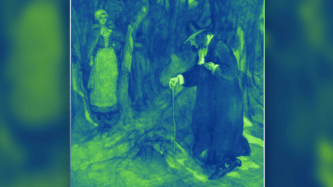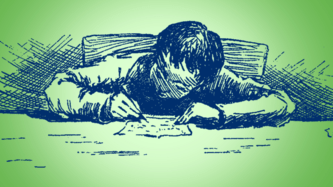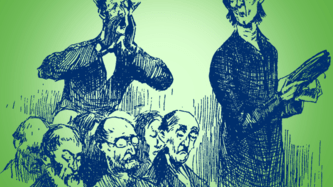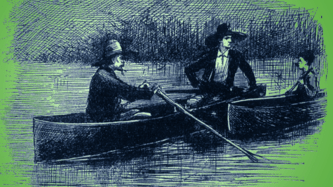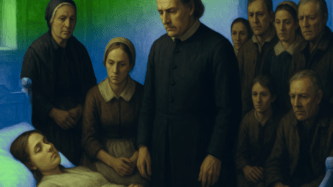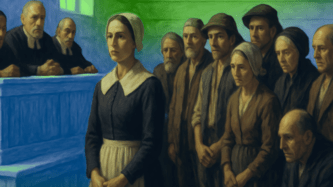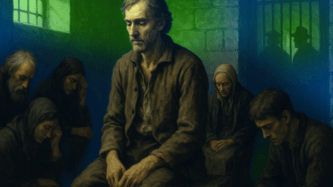module
Democracy Through Literature
The lessons in this module develop thoughtful readers who approach challenging texts as travelers, bringing both cognitive empathy and critical analysis to their journeys. In these lessons, students explore The Scarlet Letter, The Adventures of Huckleberry Finn, and The Crucible through the lens of the Declaration of Independence, examining how the Declaration informed and influenced American authors across different historical moments.

Units
Reading as Traveling
Reading as Traveling
These lessons help students approach texts with both cognitive empathy and critical analysis. Through the opening activities, students explore reading American literature as a form of travel, deepening their appreciation for the journey these works offer.
Lesson
Literary Doorways Through Time
The first opening lesson in our Democracy Through Literature unit uses visual literacy and close reading to help students understand how authors from different eras wrote about and responded to their specific time and place.
Lesson
Books, the Declaration of Independence, and the Founding of the American Mind
The second opening lesson in our Democracy and Literature unit explores how reading shaped the writers of the Declaration of Independence. Students examine how attention influences expression while learning to empathize with and critically analyze varying perspectives.
The Scarlet Letter
The Scarlet Letter
This unit guides students through The Scarlet Letter by exploring the layered perspectives in Nathaniel Hawthorne’s writing and investigating how the Declaration of Independence sets the stage for literary conversations. By engaging in these lessons, students will develop nuanced interpretations of American literature by considering America’s founding principles alongside the historical struggles to apply them equally and universally.
Lesson
Lesson 1: Unraveling Truths Through the Scarlet Letter
This opening lesson explores how the Declaration of Independence influenced Nathaniel Hawthorne. Students build a foundation for understanding layered perspectives in his work and how the Declaration set the stage for literary conversation.
Lesson
Lesson 2: Coming to Terms with Equality Through The Scarlet Letter
The second lesson asks students to compare 2 works by Hawthorne and write an analysis essay. Students explore nuanced interpretations of his viewpoint and reflect on how his writing reveals historical challenges of applying the Declaration’s principles equally and universally.
Lesson
Lesson 3: Claiming Unalienable Rights Through The Scarlet Letter
The third lesson examines the role of symbols in deepening our understanding of characters’ choices. Through visual literacy, discussion, and a synthesis essay, students explore Hester’s journey in light of the Declaration’s principle of unalienable rights.
Lesson
Lesson 4: Negotiating Consent of the Governed in The Scarlet Letter
The final lesson of this unit explores “consent of the governed” by making connections between settings and character development. Students compare the forest and civil society, then collaboratively show how these settings represent negotiations of personal freedom and consent.
The Adventures of Huckleberry Finn
The Adventures of Huckleberry Finn
This unit guides students through The Adventures of Huckleberry Finn by engaging with Mark Twain’s writing through the lens of the principles of the Declaration of Independence. As students read and ruminate on the text, they will explore the role of realism in developing a space for democracy in American literature and consider how the major themes of the novel relate to the principles of equality and liberty as intended by the Founding Fathers.
Lesson
Preface to Lessons on Huckleberry Finn
This preface offers educators practical strategies and tips as they prepare to teach Mark Twain’s novel. The goal of this explainer is to support teachers in creating spaces that foster viewpoint diversity and civil discourse, so students can have meaningful conversations about Huckleberry Finn without shying away from the challenges the text presents.
Lesson
Lesson 1: Unpacking Language and Meaning in Huckleberry Finn
This opening lesson teaches students to engage with Mark Twain’s language through reflective journaling. As they engage in the activities, students will collaborate with others to develop journaling practices that foster cognitive empathy and critical analysis of Huckleberry Finn.
Lesson
Lesson 2: Democracy Through Huck’s Eyes in Huckleberry Finn
The second lesson of this series explores the role of realism in developing a space for democracy in American literature. Students will consider the extent to which both art and literature can reflect democratic principles and societal norms, and they will critically analyze how Twain uses realism in The Adventures of Huckleberry Finn.
Lesson
Lesson 3: Navigating Toward Self‐Evident Truths in Huckleberry Finn
In lesson three, students read chapters 16–30 of The Adventures of Huckleberry Finn and consider the tension Twain develops between performative and authentic language. Through a series of scaffolded learning activities, students reflect on how Twain’s language shapes the story’s meaning, keeping an eye on the Declaration’s principle that “all men are created equal,” while understanding America’s historical difficulties in universally applying this principle to everyone.
Lesson
Lesson 4: Charting Democratic Truths in Fictional Waters in Huckleberry Finn
The final lesson in this unit helps students understand the role of situational irony and how Twain uses this literary device to add meaning to the message he conveys in the novel. At the end of this lesson, students will write a synthesis essay that explores the novel’s major themes in relation to the principles of equality and liberty as intended by the Founding Fathers.
The Crucible
The Crucible
This unit asks students to consider how The Crucible grapples with the principles outlined in the Declaration of Independence — specifically through the tensions revealed within and among the play’s characters. After exploring each act of the play in depth, students will be asked to come to their own conclusions about whether or not The Crucible is relevant to our current moment.
Lesson
Lesson 1: Exploring Equality and Individual Rights Through The Crucible
In this opening lesson, students warm up with an anticipation guide, learn about the key components of a Greek tragedy, and get to know the characters in act 1. This foundational knowledge sets the stage for the rest of the play, so students can better understand how The Crucible grapples with the principle that “all men are created equal” outlined in the Declaration of Independence.
Lesson
Lesson 2: Testing the Consent of the Governed Through The Crucible
In the second lesson, students consider the principle of “the consent of the governed” from the Declaration of Independence in relation to the dynamics and character development in acts 2 and 3 of The Crucible. After identifying how the symbols in acts 2 and 3 contribute to understanding of the key themes, students will develop a well‐written essay that explores how literary elements in The Crucible affect the audience’s engagement with the play.
Lesson
Lesson 3: Confronting the Pressure to Conform Through The Crucible
The final lesson asks students to consider the ways The Crucible serves as an allegory, revealing the tension between unalienable rights and the social pressure to conform. After participating in learning activities that help them identify and explain elements that enhance the allegorical meaning of The Crucible, students have an opportunity to come to their own conclusions about whether or not The Crucible is relevant to our current moment.




